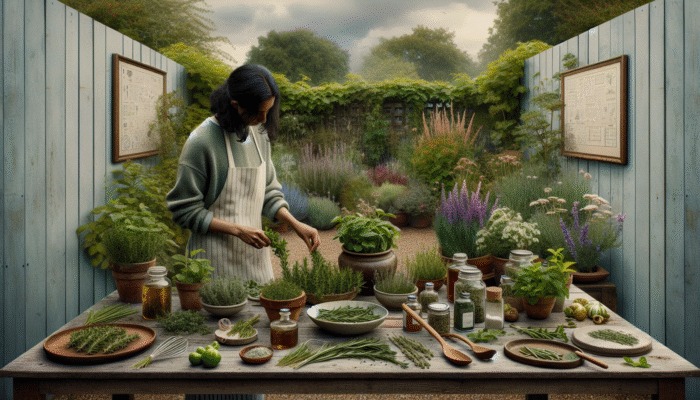Delve into the Rich Herbal Heritage of the UK: An Exploration Through History
Discover the Historical Importance and Evolution of Herbal Practices

The history of herbal practices in the United Kingdom is a fascinating narrative that spans centuries, originating from ancient civilisations where the utilisation of herbs played a pivotal role in healing and everyday life. The Druidic traditions embraced by the Celtic people held various plants in high esteem, celebrating their mystical properties and healing capabilities. This reverence endured through the medieval era, during which herbal remedies became fundamental to healthcare practices. Important manuscripts, such as the *Bald's Leechbook*, created by the ancient Anglo-Saxons, serve as invaluable resources detailing local flora and their medicinal uses. The Renaissance further ignited interest in herbalism, spearheaded by influential figures like Nicholas Culpeper, who advocated for the integration of local herbs into therapeutic practices.
In contemporary times, the legacy of these ancient traditions remains vibrant within various communities throughout the UK, often merging harmoniously with modern wellness trends. Today's herbalists are committed to sustaining these time-honoured customs while infusing them with contemporary insights into health and wellbeing. By harnessing local herbs, they champion sustainability and reinforce the bond between individuals and their natural surroundings. Understanding this historical backdrop is essential for anyone aspiring to craft personalised herbal blends that pay homage to these rich traditions.
Unveiling the Rich Diversity of Herbs Found in the UK
The United Kingdom boasts an impressive array of climates and ecosystems, each nurturing a diverse assortment of herbs that offer a multitude of therapeutic and culinary advantages. In the rugged highlands of Scotland, you will discover heather and bog myrtle, both celebrated for their cleansing and purifying properties. In contrast, the southern coastal regions benefit from a Mediterranean climate that supports vibrant herbs like rosemary and thyme, flourishing under the warm sun.
In the enchanting woodlands of Wales, wild garlic carpets the forest floor during spring, presenting exciting culinary possibilities and notable health advantages, including its antimicrobial properties. The eastern parts of England are renowned for their plentiful chamomile, famed for its calming and soothing effects. By familiarising yourself with these regional herbal varieties, you can create distinctive blends that encapsulate the essence of the UK's exquisite botanical heritage. This knowledge is indispensable for anyone aiming to blend herbs effectively and sustainably.
The Cultural Role and Significance of Herbs in British Society
In the UK, herbs occupy a significant position within cultural history, often interwoven with folklore and traditional practices. For example, the age-old practice of employing St. John's Wort during the summer solstice reflects a deep-seated belief in its protective and healing properties. Local festivities, such as the annual Herb Festival in the Cotswolds, celebrate these plants, highlighting their historical and medicinal significance.
Moreover, various communities possess unique herbal lore, with tales passed down through generations that enrich the blending experience. Grasping these cultural narratives allows individuals to connect with the profound meanings behind their selected ingredients. The symbolism associated with herbs, such as the use of rosemary for memory and remembrance, introduces layers of significance that transform custom blends into rich narratives encapsulated in every bottle.
Choosing the Ideal Herbs for Your Blends in the UK

Identifying Popular Herbs Used Across the UK
To create bespoke herbal blends, it is essential to familiarise yourself with the commonly used herbs throughout the UK. Among the most favoured options, mint flourishes in gardens and hedgerows, exuding a refreshing aroma that is perfect for both culinary and medicinal applications. Another noteworthy herb, nettle, though often underestimated, offers a wealth of health benefits, including anti-inflammatory properties and a nutrient-rich profile.
Thyme is cherished for its versatility in cooking, enhancing the flavour of numerous dishes while also acting as a potent antiseptic. Additionally, the distinctive aroma of rosemary elevates savoury meals and carries historical associations with improved memory and cognitive function. By selecting these herbs, individuals embark on an exciting journey into the realm of custom blends tailored to their unique tastes and health objectives.
Grasping the Seasonal Availability of Herbs
Understanding the seasonal availability of herbs is vital for those eager to create personalised blends. The UK experiences varied seasons, each presenting a unique selection of herbs. In the refreshing spring, herbs like chives and wild garlic sprout, making them ideal for invigorating blends. The summer months bring forth a bounty of flavours, with herbs such as basil and dill reaching their peak, perfect for enhancing salads and dressings.
As autumn approaches, heartier herbs like sage and thyme become more prominent, imparting grounding flavours suitable for comforting, warming dishes. Although winter might appear sparse in fresh herbs, dried varieties like oregano and rosemary can still be effectively integrated into blends. Being aware of these seasonal transitions allows for the creation of herbal blends that not only taste delightful but also align with sustainable practices and the natural rhythms of the environment.
Finding High-Quality Herbs for Your Blends

Sourcing premium-quality herbs is crucial for crafting effective herbal blends. Local farmers' markets offer excellent opportunities to discover fresh, organic herbs that often represent their peak flavour and potency. Additionally, herbal apothecaries and specialty shops frequently provide dried herbs that are ethically sourced and meticulously prepared.
Engaging with local herb growers can also yield invaluable insights into specific herb varieties and their appropriate applications, enhancing your blending experience. When sourcing herbs, it is essential to consider factors such as sustainability and organic practices to ensure that the herbs positively contribute to both personal health and the wellbeing of the planet. By prioritising quality ingredients, you can significantly enrich the effectiveness and enjoyment of your herbal concoctions.
Growing Your Own Herbs for Customised Blends
Growing your own herbs is one of the most rewarding methods to guarantee a continuous supply of fresh ingredients for your custom blends. The UK climate is favourable for cultivating a broad range of herbs, making home gardening both practical and enjoyable. Start with a modest selection, such as basil, parsley, and mint, which are relatively straightforward to grow and thrive well in pots or garden beds.
The quality of soil plays a vital role in herb cultivation; incorporating compost can enhance nutrient availability and promote healthy growth. Adequate sunlight is another critical aspect, as most herbs require a minimum of six hours of direct sunlight each day. Therefore, selecting a sunny spot in your garden or utilising a windowsill can be beneficial. Indoor gardening also provides a viable option, especially for those with limited outdoor space. With attentive care, homegrown herbs yield a continuous supply of fresh ingredients, perfect for creating delightful custom blends.
Preserving Herbs for Year-Round Availability
Preserving herbs is essential for retaining their flavour and aroma throughout the year, allowing you to enjoy the benefits of your homegrown or sourced herbs long after the growing season has concluded. Drying is one of the most popular preservation methods, with techniques ranging from air drying to using a dehydrator. Air drying is straightforward and involves hanging herbs upside down in a dark, well-ventilated area until they are entirely dry.
Freezing is another effective preservation technique, especially for herbs like basil and mint. By chopping the herbs and placing them in ice cube trays filled with water or oil, you can easily freeze them for later use in soups and stews. Proper storage is crucial; ensure that herbs are kept in airtight containers, protected from light and humidity, to maintain their potency. By mastering these preservation methods, you’ll ensure a consistent supply of high-quality herbs for your custom blends throughout the year.
Advanced Techniques for Crafting UK Herbal Blends
Creating Harmonious Flavours in Your Herbal Blends
Crafting balanced herbal blends necessitates a nuanced understanding of various flavour profiles. Each herb possesses unique characteristics—some are bold and pungent, while others are delicate and subtle. The key to successful blending is to achieve a harmonious flavour profile, ensuring that no single herb overpowers the others. For instance, pairing robust rosemary with milder herbs like parsley can produce a well-rounded blend.
Experimentation with proportions is vital. Start with small batches, adjusting the ratios to accommodate your taste preferences. Continuously tasting as you blend will aid in identifying the right balance and enable timely modifications. Incorporating complementary flavours can elevate the overall blend; for example, combining herbs that share similar aromatic compounds can enhance synergy within the mixture. Ultimately, mastering the art of balancing flavours is essential for crafting unique custom blends that are not only delightful to the palate but also effective for their intended uses.
Mastering Drying and Storage Techniques for Herbs
Acquiring expertise in drying and storing herbs is fundamental for preserving their potency and flavour. After harvesting, ensure that herbs are washed and thoroughly dried to prevent mould growth during storage. Various techniques can be employed for drying, including air drying, oven drying, or dehydrating. Air drying, the most traditional method, involves tying herb bundles together and suspending them in a dark, cool location with good airflow.
Once dried, herbs should be stored in airtight containers, preferably glass jars, and kept in a cool, dark environment. Labeling containers with the herb name and the date of drying can help you monitor freshness. Dried herbs can lose potency over time; therefore, it’s essential to regularly check for aroma and flavour. By implementing these drying and storage techniques, you can ensure that your herbal blends maintain their vibrant characteristics and deliver optimal benefits.
Understanding Mixing Ratios for Effective Herbal Blends
Mastering ideal mixing ratios is crucial for creating successful herbal blends. Each herb contributes unique properties, and understanding how to balance these elements can lead to a more harmonious result. A general guideline suggests using a base herb that comprises 50% of the blend, complemented by supporting herbs at 25% each. This ratio provides a solid foundation while allowing the distinctive qualities of each herb to shine through.
When determining ratios, consider the intended application of your blend; for instance, if you are crafting a blend for digestive health, herbs known for their digestive benefits, such as peppermint and ginger, may warrant higher proportions. Conversely, more pungent herbs like sage should be used sparingly. Experimentation is key; maintaining meticulous notes on each blend you create, including the ratios and observed effects, empowers you to refine your approach over time. Mastering mixing ratios will elevate your herbal blending skills, enhancing the effectiveness of your custom formulations.
Unlocking Health Benefits with UK Herbal Blends
Formulating Herbal Blends to Enhance Digestive Health
Creating herbal blends that support digestive wellness is both advantageous and fulfilling. Herbs such as peppermint, known for its ability to alleviate bloating and indigestion, serve as exceptional ingredients in a soothing blend. Additionally, incorporating ginger can enhance digestive function and stimulate appetite, rendering it a valuable component of any digestive blend.
Fennel seeds are another outstanding herb frequently employed to relieve gas and discomfort. When formulating a digestive blend, consider combining these herbs in equal parts to achieve a balanced profile or adjusting according to personal taste preferences. Brewing these blended herbs into a tea can be particularly effective, allowing for the gentle extraction of their health benefits. By focusing on digestive wellness, you can create blends that not only satisfy the palate but also significantly enhance overall health.
Crafting Herbal Blends to Strengthen Immune Function
With the increasing focus on immune health, creating herbal blends designed to bolster the immune system is a timely endeavour. Elderberry stands out as a key ingredient, celebrated for its antiviral properties and rich antioxidant content. When paired with echinacea, this blend further enhances immune function, as echinacea is renowned for stimulating the body’s natural defence mechanisms.
Furthermore, consider including thyme for its antimicrobial properties and vitamin C-rich herbs like lemon balm. The blend should be crafted thoughtfully, with elderberry serving as the primary ingredient, supported by equal parts of the other herbs. Infusing these herbs into syrups, tinctures, or teas can amplify their effectiveness, providing a delightful and impactful means to support immune health. By prioritising immune support in your blending journey, you will create a collection of powerful mixes that can be enjoyed throughout the year.
Designing Herbal Blends for Stress Relief and Relaxation
In our fast-paced world, crafting herbal blends aimed at alleviating stress is increasingly sought after. Herbs such as chamomile, known for their calming properties, serve as an excellent foundation for these blends. Lavender also stands out, cherished for its soothing aroma and its ability to promote relaxation.
Combining these calming herbs with valerian root can enhance the blend’s effectiveness, as valerian is commonly used to alleviate anxiety and improve sleep quality. When combining these herbs, consider a 3:1 ratio of chamomile to lavender, followed by a smaller portion of valerian, to achieve a soothing and balanced mix. These blends can be utilised as teas or added to bath infusions, providing a holistic approach to stress relief. By focusing on stress-relieving properties, your custom blends will offer much-needed respite in daily life.
Exploring Culinary Uses for UK Herbal Blends
Crafting Savoury Herbal Blends to Enhance Flavours
Herbs play a pivotal role in enhancing the flavours of savoury dishes, and creating custom blends can significantly elevate culinary creations. A classic herb blend in UK cuisine combines thyme, rosemary, and sage, making it perfect for seasoning roasted meats and vegetables. These herbs complement each other beautifully, with thyme’s earthy notes harmonising with rosemary's robust flavour and sage's slightly peppery essence.
For a Mediterranean flair, consider blending basil, oregano, and parsley. This combination is ideal for pasta sauces and pizza toppings, delivering a burst of flavour that transports you to the sun-kissed coasts of Italy. Experimenting with proportions based on personal tastes is encouraged; feel free to add a pinch of salt or lemon zest to amplify the natural flavours of your blends. The versatility of culinary herbal blends can transform ordinary meals into extraordinary gastronomic experiences.
Creating Sweet Herbal Blends for Dessert Applications
Unleashing the potential of herbs in sweet dishes opens up a realm of flavour possibilities. A delightful combination is mint and chocolate, perfect for desserts like brownies or mousses. Another popular blend features lavender, which can add a floral note to baked goods, pairing exquisitely with honey or lemon.
For a refreshing summer beverage, blending basil with strawberries creates an invigorating flavour profile that can be adapted for smoothies and cocktails. When establishing ratios, remember to enhance sweetness; for instance, using more strawberries than basil will ensure the blend remains enjoyable. By exploring sweet herbal blends, you’ll discover innovative ways to elevate desserts and beverages, delighting your guests and palate alike.
Formulating Marinades and Rubs with Herbal Ingredients
Herbal blends are ideal for crafting marinades and rubs that infuse meats and vegetables with rich flavours. A robust mixture of garlic, rosemary, and thyme serves as an excellent marinade for lamb, enhancing its natural richness. A blend of lemon zest, oregano, and parsley imparts freshness and brightness to chicken dishes.
Creating a spice rub can yield equally delicious outcomes; combining smoked paprika, cumin, and coriander with fresh herbs adds delightful depth to meats. The key is to allow sufficient marinating time—at least a few hours or overnight for maximum flavour infusion. Customising these blends to suit your flavour preferences will enhance your culinary creations, ensuring that each meal is memorable and inviting.
Infusing Oils and Vinegars with Herbal Flavours
Infusing oils and vinegars with herbs is an elegant method for adding a gourmet touch to everyday meals. A classic combination is garlic and rosemary-infused olive oil, perfect for drizzling over roasted vegetables or artisan bread. To achieve this infusion, combine the herbs with oil and allow them to steep for several weeks, ensuring the flavours meld beautifully.
Consider blending herbs such as tarragon or thyme with white wine or apple cider vinegar for a fresh twist. This infusion process not only enhances flavour but also increases the health benefits of the vinegar. Incorporating these infused oils and vinegars in dressings or marinades will add depth and character to your meals. Embracing the art of infusion broadens your repertoire of herbal blends, enriching your cooking experience.
Navigating Safety and Legal Considerations for Herbal Blends in the UK
Understanding the Regulatory Framework for Herbal Products
Grasping the regulations surrounding herbal blends in the UK is essential for ensuring safety and compliance. The Food Standards Agency (FSA) provides comprehensive guidelines on the safe use of herbs and herbal products, safeguarding consumers. Herbalists and enthusiasts must stay informed about the legal requirements governing the sale and distribution of herbal blends.
Herbal products intended for medicinal use may also fall under the jurisdiction of the Medicines and Healthcare Products Regulatory Agency (MHRA). Adhering to these regulations guarantees that products are safe for consumers, minimising potential health risks. Moreover, understanding the regulatory landscape encourages ethical practices within the herbal community, fostering trust and transparency among consumers and suppliers.
Adhering to Safe Dosage Recommendations When Using Herbs
Following safe dosage recommendations is crucial when developing and utilising herbal blends. Each herb comes with its recommended dosage, and exceeding these amounts can lead to adverse effects. For instance, while chamomile is generally regarded as safe, excessive consumption may result in unwanted side effects such as nausea.
It is advisable to consult reputable sources or qualified herbalists when determining dosages, particularly for individuals with pre-existing health conditions or those currently on medication. Crafting blends with a focus on moderation will optimise their effectiveness and minimise risks associated with overconsumption. By being diligent about safe dosages, you can fully enjoy the benefits of your herbal blends without compromising your health.
Prioritising Allergen Awareness in Herbal Blending
Being cognisant of common allergens present in herbs is essential for ensuring safety in your custom blends. Many individuals may have sensitivities or allergies to specific herbs, especially those belonging to the Asteraceae family, including chamomile and echinacea. Recognising these potential allergens allows you to create blends that cater to a variety of dietary needs.
Clear labelling is paramount when sharing or selling your herbal blends. Including a comprehensive list of ingredients and potential allergens ensures that consumers can make informed decisions. Additionally, educating yourself about cross-reactivity among herbs can enhance safety measures. By prioritising allergen awareness, you’ll contribute to a more inclusive and safe environment for all herbal blend enthusiasts.
Engaging in UK Herbal Workshops and Educational Opportunities
Exploring Local Herbal Workshops and Community Events
Participating in herbal workshops and courses across the UK presents a wonderful opportunity to deepen your knowledge and skills in herbal blending. Numerous organisations and herbalists offer practical experiences tailored to all levels of expertise. From foundational classes that cover the basics of herbalism to advanced workshops focusing on specialised areas, there is a wealth of options available for everyone.
Local community centres, botanical gardens, and herbal societies frequently host these workshops, fostering connections with like-minded individuals. Additionally, online platforms have emerged, providing virtual workshops that reach a broader audience. Engaging in these educational experiences not only enhances your blending techniques but also cultivates a sense of community and connection to the expansive world of herbs.
Learning from Experienced Herbal Practitioners
Learning from seasoned herbalists and practitioners can profoundly enrich your herbal blending journey. Many workshops are led by experts who share their extensive knowledge and passion for herbs, providing insights that extend beyond the basics. These instructors often weave personal anecdotes, historical applications, and contemporary practices into the learning experience, making it both relatable and engaging.
Consider seeking mentorship opportunities with local herbalists or attending informative talks and seminars hosted by experienced professionals. The knowledge gained from these interactions can guide your blending practices and deepen your understanding of the herbal landscape in the UK. By tapping into the wisdom of experts, you can accelerate your journey towards becoming a skilled and knowledgeable herbal blender.
Gaining Practical Experience in Herbal Blending
Acquiring hands-on experience in creating herbal blends is invaluable for anyone serious about herbalism. Many workshops offer practical activities, enabling participants to experiment with various herbs, explore blending techniques, and develop custom blends. This experiential learning fosters confidence and enhances understanding of how different herbs interact.
Furthermore, participating in group activities encourages discussions about preferences, techniques, and challenges faced by fellow herbal enthusiasts. This collaborative atmosphere promotes the sharing of ideas and nurtures creativity. By immersing yourself in hands-on experiences, you’ll refine your skills and cultivate a deeper appreciation for the art of herbal blending.
Sharing Your Unique UK Herbal Blends with the Community
Building Community Connections Through Herbal Sharing
Sharing your herbal blends with local communities fosters connections and inspires others to explore the world of herbs. Consider hosting workshops, pop-up events, or community gatherings where you can demonstrate blending techniques and showcase your creations. Local farmers' markets provide an excellent platform for presenting your blends, enabling direct customer engagement and allowing you to share your passion for herbs.
Collaborating with local wellness centres, cafes, or shops can broaden your reach, providing opportunities to introduce your blends to a wider audience. Encouraging feedback from the community will assist in refining your blends and creating a supportive network of herbal enthusiasts. By actively participating in community sharing, you’ll contribute to a culture of appreciation and education surrounding herbs.
Utilising Online Platforms to Share Your Herbal Creations
Leveraging UK-based online platforms is a strategic approach for sharing and selling your herbal blends. Websites like Etsy or local online marketplaces enable you to reach a broader audience while showcasing your unique offerings. Building an online presence through social media can foster engagement and connect you with individuals who share similar interests.
Creating informative content, such as blog posts or videos detailing your blending process, can enhance your visibility and attract potential customers. Sharing your knowledge and experiences establishes credibility and positions you as a trusted source within the herbal community. By effectively utilising online platforms, you can significantly expand your reach and share your herbal blends with a global audience.
Embracing Feedback for Continuous Improvement
Gathering feedback from users of your herbal blends is crucial for ongoing enhancement. Encourage customers to share their experiences and insights through reviews or direct communication. This dialogue can provide invaluable information regarding taste preferences, effectiveness, and potential areas for improvement.
Utilising this feedback to iterate on your blends demonstrates a commitment to quality and customer satisfaction. Regularly revisiting and adjusting your recipes based on user experiences improves your products and strengthens customer loyalty. By fostering a culture of feedback and continuous improvement, you’ll ensure that your herbal blends resonate with those who use them.
Frequently Asked Questions About Herbal Blending
Which herbs are suitable for beginners?
Beginners should consider starting with herbs like basil, mint, and parsley, as they are easy to cultivate and versatile in culinary applications. These herbs can also be utilised in simple blends to explore various flavour combinations.
Is it acceptable to substitute dried herbs for fresh ones?
Yes, dried herbs can replace fresh ones; however, keep in mind that dried herbs are more concentrated. Adjust the quantities accordingly—generally, one part dried herb is equivalent to three parts fresh herb.
How can I verify if my herbs are safe for use?
Research the properties of each herb and consult reputable herbal resources or professionals. It is essential to check for known allergies and understand safe dosages for the herbs you intend to use.
What are the most effective methods for preserving herbs?
The best preservation methods for herbs include drying, freezing, or creating infused oils and vinegars. Each technique helps maintain the flavour and potency of herbs for future use.
Are there any herbs I should approach with caution?
Certain herbs, such as St. John's Wort or comfrey, may interact with medications or possess contraindications. Always consult a healthcare professional before using new herbs, especially if you are pregnant or taking medication.
Can I legally sell my herbal blends?
Yes, you can sell your herbal blends, but you must comply with UK regulations regarding the sale of food products. Proper labelling and adherence to safety guidelines are essential for legal compliance.
How do I achieve a balanced herbal blend?
Begin by selecting a base herb and then introduce supporting herbs in smaller proportions. Experiment with different ratios and tastes to achieve a harmonious blend.
What are some common uses for herbal blends?
Herbal blends can be utilised in teas, culinary dishes, marinades, skincare, and medicinal applications. Their versatility makes them suitable for various purposes, enhancing flavour and health benefits.
Where can I expand my knowledge about herbalism?
Consider attending workshops, reading literature from herbal experts, or joining local societies. Online resources, webinars, and courses are excellent avenues for broadening your understanding.
What tools are essential for blending herbs?
Basic tools include a mortar and pestle or spice grinder for grinding herbs, measuring spoons for accuracy, and airtight containers for storage. A precise scale can also help achieve accurate measurements.
Connect with us on Facebook!
The Article: How to Create Custom Herbal Blends: A UK Guide appeared first on https://mcrtherapies.co.uk
The Article Custom Herbal Blends: Your Essential Guide for the UK Was Found On https://limitsofstrategy.com

